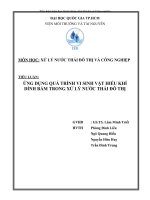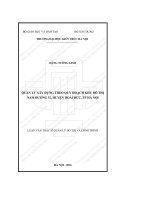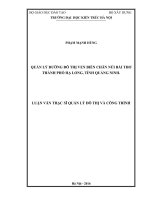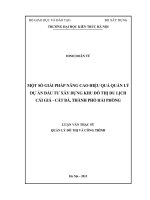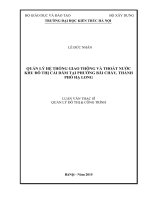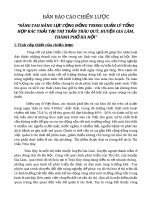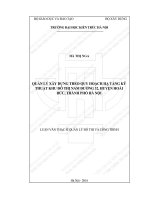Nghiên cứu tương quan giữa dòng vật chất và năng lượng trong quản lý chất thải đô thị, áp dụng cho một quận nội thành của thành phố hà nội TT TIENG ANH
Bạn đang xem bản rút gọn của tài liệu. Xem và tải ngay bản đầy đủ của tài liệu tại đây (1.61 MB, 31 trang )
MINISTRY OF EDUCATION
VIETNAM ACADEMY OF
AND TRAINING
SCIENCE AND TECHNOLOGY
GRADUATE UNIVERSITY OF SCIENCE AND TECHNOLOGY
**********************
VU THI MINH THANH
STUDYING THE CORRELATION BETWEEN THE MATERIAL
AND ENERGY FLOW IN URBAN WASTE MANAGEMENT,
APPLYING TO AN INNER-CITY DISTRICT OF HANOI CITY.
Major: Enviromental Engineering
Code: 9 52 03 20
SUMMARY OF DOCTORAL THESIS
IN ENVIRONMENTAL ENGINEERING
Hanoi - 2021
The thesis was completed at: Graduate University of Science and
Technology - Vietnam Academy of Science and Technology
Supervisor 1: Prof.Dr. Tran Hieu Nhue
Supervisor 2: Prof.Dr. Nguyen Thị Hue
Reviewer 1:
Reviewer 2:
Reviewer 3:
The dissertation was be defended at the Academic Review Board, of the
Graduate University of Science and Technology - Vietnam Academy of
Science and Technology at…..
The dissertation can be reached at:
- Library of the Graduate University of Science and Technology
- Vietnam National Library
1
INTRODUCTION
1. The necessity of this topic.
The fast urbanization speed in Vietnam has create a large volume of waste,
a majority of which is not treated. The volume of generated municipal
wastewater of cities in 2018 was approximately 7 million m3/day [1] (which
has become over 10 million m3/day in 2020); household solid waste (HSW)
volume is 61,600 tons/day, within which municipal solid waste (MSW) is
around 37,200 tons/day [2] and increases 12% per year on average. Only about
13% of municipal wastewater is treated at wastewater treatment plants
(WWTP) [1], septic tank sludge are suctioned mostly by private companies
and then discharged without treatment into the environment [3]. Over 71% of
municipal waste is buried [2] which creates overloading at landfills.
The activities of WWTPs and solid waste (SW) cost a lot of energy. If
there is a waste management (WM) model that directs towards resource
recovery and energy production, it can both solve environmental problems and
bring about economic benefits. In Vietnam, in the field of Urban and
Environmental Infrastructure Engineering, there is not yet a model that fully
considers the connection between material and energy streams in WM.
Wishing to provide more scientific basis for analyzing, evaluating, and
planning, as well as providing reliable information to select the appropriate
waste treatment (WT) technology and WM model, the author implements the
thesis: "Studying the correlation between the material and energy flow in
urban waste management, applying to an inner-city district of Hanoi city".
2. Purpose and research contents of the thesis
1) Objectives of the thesis:
- Analyzing the relationship between waste flows and energy flows in
MSW management through the quantification of wastewater, septic tank
sludge, sewage sludge from WWTP, and organic fraction (OF) of MSW flows.
- Determining the relationships among above mentioned organic-rich
waste lines through mass balance and energy balance quantification for a
selected case study, from where a sustainable urban wastewater, sludge and
SWM model is proposed.
2) Research contents of the thesis:
(1)- Studying the relationship between waste and energy flows in MSW
management systems in Vietnam and the world.
(2) – Researching the mass, composition, and characteristics of the
organic-rich MSW flows, as well as WT methods in the direction of resource
recovery.
2
(3)- Experimental research on the composition and properties of WWTP
sludge, septic tank sludge, and HSW, as well as the ability to recover energy
from the anerobic decomposition process of HSW.
(4)- Conducting specific case studies: development of waste management
scenarios (wastewater, sewage sludge, septic tank sludge and MSW; quantify
the above material flows, energy consumption and potential energy that can
be obtained from above WT processes; material flow analysis (MFA) and
energy balance (EB) for each scenario.
(5)- Assessing results, proposing methods of MSW management in the
direction of resource recovery, towards cyclic economy
3. Subjects and scope of research
- Subjects of research: organic-rich waste flows in urban waste
management: septic tank sludge, sewage sludge, OFMSW; relationships of
these waste flows, through mass balance and energy balance calculations.
- Scope of study: In area: Hanoi city, with case study in Long Bien
district; In time: from present to 2030, with vision to 2040.
4. Research methods
The thesis has used the following research methods: Inheritance methods;
Field survey methods; Experimental methods; Comparative method;
Analytical methods; Simulation method; Expert methods.
5. Scientific and practical significance of the thesis
Scientific significance
- The thesis has fully considered the relationship between material and
energy flows in the MSW management system through combining MFA and
EB analysis. This method allows effective evaluation of MSW management
models in technical, environmental, management and economical aspects.
- The material balance and energy balance of the system performed on the
same diagram is a new, scientifically significant approach. This method can
continue to be developed and applied to other similar problems.
- The thesis has identified some important parameters of the composition
and properties of organic waste lines such as sludge from WWTP, septic tank
sludge, organic HSW, as well as identifying the potential of methane
generation from the anaerobic decomposition of urban organic SW.
- The thesis defines the energy demand and potential energy recovery per
waste unit, and the potentially recovery of embodied energy per capita, as a
basis for other studies.
Practical significance
- The management model combining organic waste at the urban waste
3
treatment center (WTC) on a district scale towards resource recovery from
anaerobic digestion and other related processes is very potential, bringing
multiple benefits. This meets the practical needs of Vietnam where so far there
is no appropriate, effective and sustainable urban waste management model
(both for SW, septic tank sludge, wastewater, and sewage sludge).
- This result can be considered for application when formulating or
adjusting wastewater and SW management planning in urban areas.
- Long Bien District wastewater and SW management plans have not yet
been implemented. The thesis’ results can be considered as a scientifically
based proposal for authorities and interested investors.
- Simulation tools for material flows (STAN) and energy balance
(SANKEY) can help leaders to have a visual view, easy to detect problems,
to make the right and appropriate decisions.
6. The novelty of the thesis
(1) - The theory has proposed the model of general management with resource
recovery, towards the realization of cyclic economy. By combining material
balance and energy balance calculations, using the MFA and EB tools to
quantify the material flows at general sludge of WWTP, septic tank sludge,
urban HSW), the research has shown that combining anaerobic decomposition
treatment for energy generation and resource recovery from organic-rich CT
lines is very feasible.
(2) - The thesis has calculated specifically the energy demand and the potential
for energy recovery (electricity and heat) from organic waste disposal of an
urban area. On the condition of Long Bien district, Hanoi city in 2030, the
energy to handle wastewater needs 0.61kWh/𝑚" , to treat of organic HSW
combined with septic tank sludge, and to process compost is 35.83kWh/ton.
Combined bio-anaerobic decomposition treatment of MSW not only meets
100% of the energy needs of the WT center, but also produces energy in total
exceeding 222.66% of demand and can provide out 78,865.75 kWh/day of
residual electricity and 197,689.24 kWh/day of residual heat. Pre-treatment of
materials before anaerobic decomposition is with hydrolysis heat, producing
energy totaling up to 265.16% of the needs of the WT plant. Recovered energy
is calculated for 1 person in 1 year according to concrete calculated treatment
options.
(3)- For the first time, the research has determined potential energy recovery
from embodied chemical energy in municipal waste flows in Vietnamese
conditions. Excluding thermal energy and losses, potential electricity recovery
from wastewater treatment is 13.75 kWh/cap/year; from septic tank sludge is
1.33 kWh/cap/year; from OFMSW is 144.93 kWh/cap/year.
4
7. Composition of the thesis
- Opening
- Chapter 1: Overview of studies on the correlation between urban waste and
energy streams towards sustainable management of wastewater and SW.
- Chapter 2: Scientific basis and methods of wastewater treatment and urban
SW; potential for recovery of energy.
- Chapter 3: Results of research and discussion.
- Conclusion, Proposal.
CHAPTER 1. OVERVIEW OF RESEARCH ON CORRELATION
BETWEEN URBAN WASTE AND ENERGY STREAMS
TOWARDS SUSTAINABLE MANAGEMENT OF WASTEWATER
AND SOLID WASTE
1.1. Water-energy correlation in technical infrastructure and waste
management
Humans need water and energy for their essential needs. All
technological systems for energy transformation need water. Mining,
treatment, storage, distribution of water supply, collection, treatment of
wastewater and sludge residue all need energy. Water, wastewater, sludge, SW
containing latent energy can create electricity and thermal energy.
1.2. Water-energy relationship in waste management in some countries
around the world
1.2.1. Solutions to use energy efficiently and produce energy from WT
Energy saving and manufacturing solutions in water supply and
production, SW and wastewater collection/treatment are mainly: [10] [11]
- Water saving and wastewater reuse; reduce, recycle, reuse SW and sludge.
- Saving energy consumption in water supply and drainage, SW
management.
- Bio-anaerobic decomposition and bio-gas recovery to produce energy.
- Burning sludge, SW for heat, etc.
1.2.2. Saving energy consumption in WWTP
Energy consumption accounts for 25-40% of the operating costs of large
WWTP [12]. Using bio-anaerobic technology to treat sludge, with combined
heat-power system (CHP) can save an average of 42% of energy consumed
in WWTP. [22] And the potential to save 20–50% of energy in WWTP with
5
a capacity of 1,500-45,000 m" /day in Europe. [8]
1.2.3. Water reuse saves energy
Water reuse lowers by more than 5.5 times of energy compared to
saltwater dewatering (costing 2.5-2.8 kWh/m3) [23]. Rainwater collection and
supply only costs 0.3-1.2 kWh/m3 [25].
1.2.4. Production of renewable energy from MSW
Compost from organic HSW, anaerobic biodegradation of sludge to
recover methane, or SW combustion to recover heat and produce electricity
and heat have been widely applied in countries around the world.
1.3. Overview of the volume, composition, characteristics and current
status of urban wastewater and SW management in Vietnam
1.3.1. Current management of wastewater and sludge in some major
urban areas of Vietnam; Volume, composition, properties of sludge
- Hanoi: Total volume of household wastewater is 750,000 m" /day;
industrial/service wastewater ~270,000/m" day [32], with 6 concentrated
WWTP, capacity ~170,000 m" /day [31], has treated ~22% of industrial/service
wastewater.
- Ho Chi Minh City: inner-city household wastewater ~1,750,000 𝑚" /day,
[36]. industrial and service wastewater ~200,000 m" /day [37], with 3
concentrated WWTP operating, actual capacity of 185,000 m3/day, which
treats ~ 10% of service HSW.
- WWTP sludge contains many organic matter and nutrients and can be used
as fertilizer. The analysis results show that the sludge has a high organic ratio
(VS/TS ~ 60-70%), the C:N:P ratio is suitable for anaerobic stabilization, and
the N:P nutrient composition: K ~ 2.5:1.6:0.4. Currently, WWTP sludge is
mainly dewatered and then buried, only WWTP Yen So, Hanoi has an
anaerobic sludge digestion tank and collects biogas, but because the amount of
sludge generated is very small, the tank is not active, and generated biogas is
also only designed to be burned wastefully.
- Septic tank sludge: has a high humidity of 97-99% [48], so it is difficult
to collect and transport. The sludge has a high content of organic matter and
nutrients and is capable of being decomposed by biological methods; contains
many helminth eggs and pathogenic microorganisms; has high COD, ranging
from 15,600-79,500 mgO2/l; High TN, large fluctuation, 80-1689 mg/l; TP 82678 mg/l; VS/TS ~ 68%-83%; [51]. The amount of sludge generated in big
cities is ~50,000-218,490 m3/year; collection rate reached 32%, with 4% being
disposed of and landfilled in a sanitary manner [52]. URENCO Hanoi collects
6
~10% of the generated sludge (~50 tons/day) [53] [54], the remaining 90%
comes from the private sector. Hai Phong city collects about 33,000-35,000
tons/year [55]. Ho Chi Minh City collects about 300-350 m3/day, out of a total
of 2,450 m3 of sludge generated [47].
1.3.2. Current status and planning of solid waste management in major
cities of Vietnam; Mass, composition, properties of urban organic solid
waste- In Hanoi: The rate of solid waste collection in the inner city is about 95%, the
suburban rate is 60% [56]; SW volume increases by 15%/year on average.
Currently, the city has 4 landfills and 3 waste disposal plants. The total volume
of MSW generated in 2017 was 7,500 tons/day, accounting for 68.7% of the
city's total solid waste [56]. Inner-city MSW is collected and brought to Nam
Son Wastewater Treatment Complex with an area of 83.5 ha and up to 95% is
buried; The complex is currently overloaded. The organic composition of
MSW reaches ~60% [2].
- Ho Chi Minh City: the amount of MSW generated in 2018 was 7,800 tons/day
[38] [2] and was treated in two main solid waste treatment complexes, which
are the Northwest Waste Treatment Complex (Cu Chi) and Da Phuoc (Binh
Chanh). The organic composition of MSW reached 57-77.1%
In 2018, the total amount of MSW collected nationwide was 22.5 million tons,
with 71% being buried, 16% composted; 13% incinerated [2]. The country has
381 incinerators, 37 composting facilities, 80% of the 904 BCLs are
unhygienic [2], with a tendency to shift from landfill to incineration [2] [50]
[64] [60].
1.4. Energy demand and potential for energy recovery from wastewater
treatment, sludge and solid waste
1.4.1. Demand for energy in water treatment
Average energy for water supply treatment and wastewater is ~ 0.2- 1.5
kWh/m3.
1.4.2. Demand for energy in solid waste management
In addition to the energy needed for solid waste collection and transportation,
composting technology consumes energy for solid waste classification,
aeration, mixing, sieving, and bagging. Combustion consumes the most
energy, but recovered heat can be utilized.
1.4.3. Potential for energy recovery from MSW lines
7
Energy can be produced from biogas recovered from landfills; from the process
of burning solid waste to generating electricity; from the anaerobic digestion
of organic-rich MSW flows. In addition to the energy produced from the
combined heat-power (CHP) system, the energy can be recovered in the form
of pellets, generated from solid waste or sludge treatment. Combined treatment
of organic-rich MSW lines by anaerobic digestion to recover energy is a
potential direction at present.
CONCLUSION OF CHAPTER 1 AND RESEARCH ISSUES
All processes of water supply, drainage, wastewater treatment, collection and
treatment of solid waste consume energy. In order to save, recover or produce
energy in urban waste management, it is necessary to apply solutions to use
energy efficiently, reuse wastewater, recover energy from processes of
treating wastewater, sludge, and solid waste.
Urban wastes such as wastewater, WWTP sludge, septic tank sludge, urban
solid waste in big cities in Vietnam are rich in organic matter and have great
potential for energy recovery. In which, anaerobic treatment combined with
organic-rich waste flows is a potential solution. The thesis sets out to build a
scientific basis and conduct quantification of material flows (water, WWTP
sludge, septic tank sludge, solid waste, products of wastewater processes),
quantification of energy consumed or generated in the treatment process, using
the MFA and EB simulation tools. Specific calculation for a district in the inner
city of Hanoi will illustrate the theoretical bases that the thesis researches,
thereby proposing a sustainable urban program management model.
CHAPTER 2. SCIENTIFIC BASIS, METHODOLOGY ON
WASTEWATER TREATMENT, URBAN SOLID WASTE AND
ENERGY RECOVERING POTENTIAL
2.1. Scientific basis in the study of water-energy correlation
2.1.1 MFA (Material Flow Analysis) Research Methodology
MFA is an effective tool with potential to be applied in strategic management,
allowing quantification of material flows [79][80] in a system, at different
scales; allows for early problem detection; can be used to forecast and evaluate
new approaches and methods [81].
2.1.2. Material flow analysis with STAN software
STAN software (subSTance flow ANalysis) solves the problems in the process
8
of using MFA [5], making MFA easy to use, highly reliable, because STAN
automatically calculates errors, verifies unknown data. Calculation results are
displayed in the form of SANKEY diagrams.
2.1.3. Research methodology on energy balance in the system of
competitive management
The principle of the energy balance problem (EB) is:
Input energy = Output energy + Accumulation
The thesis uses EB to calculate the waste treatment center, recover resources,
and use the SANKEY tool to display and analyze the results.
2.1.4. Method of determining energy consumption of equipment in
wastewater treatment facilities
Determine the power consumption capacity, the number of operating hours of
the equipment based on the technology calculations. The total power
consumption of the system is equal to the total power consumption of each
device, per unit time. Calculation results are verified with data determined by
referencing literature and taking energy consumption of similar
processes/equipment.
2.2. Technological solutions for solid waste, wastewater, and sludge
recovery
2.2.1. Biogas recovery from landfills
After closing the landfills, the anaerobic decomposition of organic compounds
will produce a significant amount of methane-rich biogas.
2.2.2. Anaerobic digestion to recover energy
There are many factors affecting the anaerobic digestion that determine the
substrate metabolism in the reaction. It is possible to combine multiple organicrich waste streams together during decomposition.
2.2.4. Pretreatment before anaerobic digestion
Pretreatment breaks down the structure of non-biodegradable components,
reduces the size of solid impurities in the sludge, improves the efficiency of
the decomposition process and produces methane.
2.2.5. Sludge burning to recover heat
The moisture content of the WWTP sludge from the SBR tank is 99%
[17], the septic tank sludge is 97.05% [95] so it must be thickened, dehydrated,
and dried before burning.
9
2.2.6. Solid waste incarceration
Incineration reduces the volume of solid waste and recovers heat, but it is 1015 times more expensive than sanitary landfilling and 8-10 times more
expensive than composting [97].
2.3. Experimental study to determine the anaerobic decomposition of
research wastes
2.3.1. Experiment purpose:
- Analysis of the composition and properties of organic-rich urban waste that
can be anaerobically digested and recovered: WWTP and septic tank sludge,
urban solid waste.
- BMP test to evaluate the methane generation ability of organic CTR. by
anaerobic digestion in warm fermentation mode (370C), determining the
specific parameters for the decomposition process, focusing on: CH4 gas yield
produced NmL CH4/gVS substrate.
2.3.2. Sampling, analyzing solid waste components:
According to TCVN 9461:2012 (ASTM D5231-92).
2.3.3. Sampling and analyzing the composition of septic tank sludge
In 2016-2017, 59 septic tanks of households in Hanoi city were sampled.
Samples were taken during sludge aspiration (private suction truck). Each
household has 3-6 people, using a septic tank for 5-20 years, with tank volume
1.2-4.0 m3, sucking up all the sludge. 10 samples/1 duplicate sample were
taken; 8 samples/1 duplicate with cross-check were analyzed, using standard
methods and HACH-Lange kit for COD, NH4 and PO4.
2.3.4. Sampling, analyzing sludge composition of WWTP
- 2016- 2017: Sampling sludge in sludge compaction tank after primary settling
tank (PS), secondary settling tank (WAS) 2 WWTP Kim Lien and Truc Bach;
Analysis in the laboratory (5 batches).
2.3.5. Experiment to determine the potential for methane generation
BMP
Seeding sludge: 40L anaerobic sludge tank, operating continuously at a
temperature of 350C±0.50C; The feed material is artificial wastewater, with
COD = 500-1,000 mg/l, C:N:P = 100:5:1; Loaded 1 time/day, load 0.5-1kg
COD/m3/day.
2.3.6. Experimental model:
10
a)
b)
d)
c)
Figure 2.2.1. Experimental model of BMP-methane production potential:
a) Reactors; b) Seeding sludge growing chamber;
c) Setting-up diagram; d) Reactor details.
The experiment was carried out from October-December 2019, with an
anaerobic reaction system in 2 batches: 3 replicate samples + 1 blank sample
each. Ratio of sludge and substrate is F/M = 0.5gVS/gVS; Sludge + Substrate
+ Nutrients = 300mL/jar. Operating temperature 350C±0.50C. Biogas is led
through 3M NaOH solution to absorb CO2. The volume of CH4 produced
daily was measured by the liquid displacement method. The experiment was
stopped after 26 days when no gas production was found.
2.4. Research on the waste management model for Long Bien district,
Hanoi city
2.4.1. Choosing a research site
Long Bien District meets all the criteria for selection:
- Having a complete database on land use planning and technical
infrastructure.
- In Hanoi, it is convenient for survey and additional data collection.
- The study area is relatively isolated, with little interference with other areas
(to ensure accurate calculation of waste flows).
- Medium and large scale WWTP capacity, so that anaerobic sludge digestion
can be applied [122]. The amount of solid waste generated is large (several
11
hundred tons/day), in order to apply appropriate treatment and recycling
technology solutions on an industrial scale [88].
- The study area includes both old and new urban areas, which can represent
many urban areas in Vietnam.
- The area has few interspersed industrial and agricultural zones.
2.4.2. Current status of water drainage, wastewater treatment and
environmental sanitation
- The drainage system is not synchronized, currently overloaded.
- Solid waste is collected at 33 collection points and brought to Nam Son
WWTP.
- Collected septic tank sludge, sludge from WWTP of industrial zones and
sludge from sewers are transported to Nam Son landfill.
2.4.3. Input data for calculation
The data from the Long Bien District Development Plan to 2030, with a
vision to 2050 [125] [127] [128] were used. Some key parameters: Population
size in 2020: 352,000 people; 2030: 428,860 people; Land area: 6038.24ha;
Standard of water use for daily life: 160l/person/day; The rate of wastewater
collection is 90%; Unit solid waste emission: 1.3kg/person/day.
2.4.4. Calculation options
Long Bien district, Hanoi city was selected as a case study on the integrated
waste management model, with 3 options for urban waste management:
- Option 1: The traditional waste management model is currently being widely
applied in Vietnam's urban areas.
- Option 2: Integrated waste management model, with a waste treatment center.
Sources of rich organic waste (organic solid waste and septic tank sludge) are
brought to the Center and treated together with WWTP sludge with anaerobic
copper digestion and energy recovery.
- Option 2a: Integrated waste management model similar to option 2, but with
an additional step of pre-treatment by pyrolysis of the waste mixture before
being put into anaerobic co-digestion tank to improve the recovery efficiency.
MFA with STAN application, and EB with SANKEY application, were
selected as calculation tools in the thesis.
The detailed technological calculation of treatment works, material flow
analysis and energy balance of the 3 options are presented in Chapter 3.
12
CHAPTER 3. EXPERIMENTAL RESULTS AND DISCUSSION
3.1. Laboratory experimental results
3.1.1. Components and characteristics of organic solid waste, septic tank
sludge, and WWTP sludge
a) Results of analysis of composition and properties of urban organic solid
waste
- Urban organic solid waste has an average VS/TS ratio = 89%
- High VS, COD values, with great gas generation potential
- COD: N: P = 229: 3.2: 1, suitable for anaerobic methane decomposition,
and tends to have excess C or lack of N, P.
Table 3.1. Analysis results of urban organic solid waste samples
Variables
pH
TS (g/l)
VS (g/l)
Sample 1
Sample 2
Sample 3
Max
6.32
6.28
6.29
6.32
154.36
152.46
158.82
158.82
141.04
137.58
138.65
141.04
Min
6.28
152.46
137.58
Average
Standard deviation
6.30
0.021
155.21
2.67
139.08
1.77
COD
(g/l)
237.7
213.5
243.8
243.8
TN (g/l)
TP (g/l)
3.45
3.19
3.09
3.45
1.07
1.02
0.94
1.07
213.5
3.09
0.94
231.67
16.03
3.24
0.19
1.01
0.07
b) Analysis results of septic tank sludge
The postgraduate has analyzed the composition and properties of septic
tank sludge in Hanoi (International cooperation project on septic tank
management). The results show that COD values = 2.83 - 83.0g/L; VS = 1.7 45.4g/L; VS/TS = 47.5 - 87.7 (average 72%); TN = 1.179mg/L; TP = 287mg/L.
COD/VS ratio = 1,946 gO2/gVS. From the analysis results, the chemical
formula of the septic tank sludge was determined to be ~ C18H39O8N, the ratio
C:O:H:N = 54.4%:32.2%: 9.8%:3.5 %.
The septic tank sludge has the ability to decompose by biological
methods, the sludge after decomposition has high nutritional value. About 50%
of the organic matter is hydrocarbons, proteins, fats, the rest is fibers (about
10g/L~ 40% TS), VFA, alcohols, amino acids, etc. VFA is quite low, average
0.12g/L.
Impurities that can inhibit and slow down anaerobic digestion are present
in the septic tank sludge: 𝑁𝐻&' , 𝑆𝑂&*+ , fibrous.
13
Solutions for high efficiency and stable anaerobic digestion:
- Pretreatment before anaerobic stabilization.
- Mix septic tank sludge with C-rich substances, creating a suitable
environment for decomposition.
c) WWTP sludge analysis results
Similar to the above, the primary sludge (PS) has a moisture content of 91 99.7%; Secondary sludge (WAS) has a moisture content of 98.8 - 99.6%;
Sludge mixture: VS/TS = 53.5 – 69.5% (lower than other countries, due to the
characteristics of wastewater collection network); high VS, COD; high
composition of hydrocarbons, proteins, fats, and gas generation potential;
COD:N:P ratio ~ 92:4,8:1, suitable for anaerobic reaction (lack of organic C);
WAS contains higher N, P and nitrogen than PS, but lower hydrocarbon and
fat content than primary sludge. With a common drainage system, the C:N:P
ratio is even lower; The mud contains many nutritional elements such as N, K,
S, Fe...; The product after stabilization can be used as fertilizer; The content of
heavy metals Cd, Pb, Cu, Zn is within the allowable threshold.
3.1.2. Determination of methane generation ability of organic solid waste
in laboratory
Table 3.2. Input material parameters of BMP experiment – batch I, II
Input material
- Experiment
batch I:
Seeding sludge
Masticated organic
solid waste
Nutrient,
micronutrients
solution
- Experiment
batch II:
Seeding sludge
Masticated organic
solid waste
Nutrient,
micronutrients
solution
Input
material
volume
(mL)
pH
275,68
7,74
8,0
6,3
16,32
TS
(g/L)
VS
(g/L)
COD
(g/L)
TN
(g/L)
TP
(g/L)
19,0
158,0
8
8,21
141,
46
13,52
0,23
0,06
237,64
2,03
0,56
7,0
-
-
-
-
-
280,77
7,72
0,24
0,06
6,28
7,79
136,
7
12,25
8,0
18,86
153,5
4
225,68
1,75
0,48
11,23
7,0
-
-
-
-
-
14
Removal efficiency: 32.03 - 42.25% by VS, 30.47 - 36.01% by COD;
The cumulative volume of CH4 gas by day, NmL/gVS is shown in Figures 3.1
and 3.2.
Average CH4 production: 390.33 NmL/gVS; Volume of CH4 as COD:
average 267.06 NmL/gCODremoved (experiment I) and 294.96
NmL/gCODremoved (experiment II); CH4 gas production efficiency by COD:
75.85 - 87.28%, average 79.75% (experiment I) and 84.74% (experiment II).
CTR in experiments BMP I and II for CH4 production was 390.33
NmL/gVS of input substrate, similar to other published research results, higher
than CH4 production from urban WWTP sludge and septic tank sludge.
The mixing of solid waste, septic tank sludge, and sludge of urban
WWTP with appropriate ratio allows to achieve feedstock with suitable
composition for anaerobic digestion, improving the efficiency of
decomposition and collection of biogas with high methane content.
Figure 3.1.
Accumulated volume
of CH4 by day,
NmL/gVS, BMP test
– series I
Figure 3.2. Accumulated
volume of CH4 by day,
NmL/gVS, BMP experiment
– series II
15
3.2. Research results on the waste collection and management model,
resource recovery for Long Bien District, Hanoi City
3.2.1. Selection of waste management and organization plans and
diagram of wastewater treatment and solid waste technology chain
a) Option 1: Traditional waste management model: Centralized wastewater
treatment plant; Sludge manure and organic solid waste are stabilized
aerobically, producing compost at the Waste Treatment Station in the same
Landfill area.
Wastewater is brought to the concentrated WWTP in An Lac, with SBR
activated sludge technology, including: Conditioning tank; The system of
mechanical treatment works: garbage screen, sand settling tank and primary
settling tank; Biological treatment system with sequencing batch reactors
(SBR); system of sludge treatment works: Sludge compaction tank and
mechanical sludge treating and drying methods. After drying, the sludge is
brought to Bo De Landfill (total area is 14.26 ha).
The collected septic tank sludge and organic solid waste are brought to Bo
De Landfill. The microbiological fertilizer factory is located in the same area
of the landfill.
Returned solid waste is classified into: reusable part (~10%); the organic
part (~58.75%), is taken to aerobic treatment with septic tank sludge,
producing microbial fertilizers; and the rest is buried.
Figure 3.3. Waste management model in Long Bien district according to Option 1
b) Option 2: Energy recovery waste management model: centralized WWTP;
sludge, septic tank and organic solid waste are stabilized anaerobically,
recovering energy from biogas at the wastewater treatment center in An Lac.
16
Figure 3.4. Model of integrated waste management according to Option 2
The collected MSW will be brought to the wastewater treatment center in
An Lac, the industrial solid waste and construction waste, and the inorganic
solid waste will be brought to the Bo De landfill. The organic solid waste is
masticated and brought to the anaerobic treatment area with the septic tank
being transported here and the discharged WWTP sludge. The wastewater
collection solution is similar to Option 1.
3.2.2. Calculation of waste treatment technology and energy demand
according to Option 1
a) Calculation of wastewater, sludge, and organic solid waste treatment
technology according to Option 1
Existing areas are public sewers, new urban areas use separate sewers. Total
capacity of An Lac treatment plant is 122,000 m3/day. The treated water
discharged into the Cau Bay river reaches column A according to QCVN
40:2011/BTNMT.
Table 3.3. Quantity and composition of solid waste and septic tank sludge to be treated
Calculation parameters
1) Domestic solid waste
Calculation area population
people
428.860
CTR emission factor
kg/person/day
1,3
Total solid waste volume
Organic solid waste Volume
tons/day
tons/day
557,5
327,54
Moisture
%
60
Density
Unit
3
tons/m
Value
1,2
17
2) Septic tank sludge
Calculation area population
People
428.860
Average number of people in a household
people/household
4,7
Number of households to calculate
household
91.247
Number of households with septic tank(s)
household
72.997
Average sludge suction cycle
Number of septic tanks suctioned per day
year
household
6,2
32,26
Average capacity of household septic tank
m3
2,6
Amount of sludge suctioned per day
Organic matter content according to COD
Total solids content, TS
Volatile organic matter content, VS
Moisture
Density
Volume of septic tank sludge
Volume of solids in septic tank
Amount of organic residue (ashless)
Amount of inorganic residue (ash)
m3/day
g/L
g/L
g/L
%
tons/m3
tons/ngày
tons/ngày
tons/ngày
tons/ngày
83,87
37,67
25,50
20,90
97,05
1,03
86,38
2,46
1,74
0,72
Calculation of required energy for the treatment processes according to
Option 1 (Table 3.4).
Table 3.4. Energy required for the treatment plant of solid waste, septic tank and
WWTP – Option 1
No.
Processing stage
Electrical
energy
consumption
kWh/day
Power
Consumption
kWh/t,
kWh/m3
I
Total electrical energy needed to treat organic
solid waste and septic tank sludge into compost
11974,38
35,83
II
Total electricity needed to supply the WWTP
74.499,93
0,61
III
Total energy needed for wastewater, solid waste,
and septic tank sludge treatment
94,474.31 (kWh/day)
18
b) Material flow analysis and energy balance calculation for Option 1:
Figure 3.5. Matter balance diagram for solid waste Figure 3.6. Analysis of electricity demand
and septic tank sludge treatment in Long Bien
for solid waste and septic tank sludge
district according to Option 1
treatment in Long Bien district according to
(according to TS, tons/day)
Option 1 (kWh/day)
Figure 3.7. Matter balance diagram for wastewater treatment in Long Bien district according
to Option 1 (TS, t/day)
Figure 3.8. Analysis of energy demand (electricity) for wastewater treatment in Long Bien
district according to Option 1 (kWh/day)
3.2.3. Calculation of waste treatment center technology and energy
demand according to Option 2
a) Calculation of waste treatment center technology according to Option 2
- The mixing ratio of organic solid waste - WWTP sludge - septic tank sludge:
the ratio of COD:N:P of the raw material mixture, when 3 waste streams are
collected to the maximum, will be COD: N : P = 128, 5:2,36:1, suitable for
anaerobic digestion.
19
- According to Option 2, the water is separated from the sludge compression
tank and in the centrifuge after anaerobic digestion, along with the extracted
water from the residual activated sludge compaction tank, which is returned
for treatment. So the WWTP capacity is 122,700 m3/day.
Table 3.5. Energy obtained from anaerobic digestion system – Option 2
No.
1
2
3
4
5
Parameter
The heat energy produced by
CH4 gas
Electricity energy collected
from CHP
Heat energy collected from
CHP
Total energy obtained from
CHP system
Energy loss
CHP
power/heat
generation
efficiency
Total energy
(kJ/day)
Total electrical
energy
converted
(kWh/day)
1.821.903.920
506.084,42
37.0%
674.104.450
187.251,24
36.0%
655.885.411
182.190,39
369.441,63
27.0%
136.642,79
Table 3.6. Energy consumed and recovered at the waste treatment center –
Option 2
Electrical
energy
consumption
(kWh/day)
Power
Consumption
(kWh/ton,
kWh/m3)
No.
Processing stage
I
Energy supplied for the process of sorting solid
waste, masticating organic solid waste and
supplying to anaerobic digesters
10.224
18,34
II
Energy needed to provide to WWTP
73.704,73
0,60
24.456,75
0,20
98.161,48
0,80
III
IV
V
VI
Energy supplied to the Sludge Treatment
System, recovering energy
Total electricity needed to supply the
wastewater treatment plant
Total electricity needed to supply the waste
treatment center
Total thermal energy needed to supply the
waste treatment plant
108.385,48
117.088,23
VII
Energy balance for the waste treatment center
1
Electrical energy generated from CHP system
Thermal energy generated from the CHP
system
187.251,24
Energy potential generated from burning pellets
132.587,08
2
3
182.190,39
20
4
Total energy that can be generated
502.028,71
5
Remaining electrical energy
78.865,75
6
Remaining thermal energy
65.102,16
b) Material flow analysis and NL balance calculation according to Option 2
Figure 3.9. Matter balance diagram for the waste treatment center in Long
Bien district according to Option 2 (according to TS, tons/day)
Figure 3.10. Analysis of energy balance (electricity and heat) for the waste
treatment plant of Long Bien district according to Option 2 (kWh/day)
3.2.4. Calculation of wastewater treatment technology and energy
demand according to Option 2A -Pre-treatment by thermal hydrolysis
pretreatment (THP):
21
THP ensures a stable decomposition process, avoiding shocks, as well
as to obtain the highest methane production efficiency (especially with input
of different streams). THP is studied for Option 2A and further optimizes the
system's performance, because the Option 2 calculation results show that there
is still excess heat.
- Select THP pressure 7 bar, temperature 165oC, sludge retention time 30
minutes. Calculation results of matter balance and energy balance on the same
diagram, Figure 3.11.
Figure 3.11. The matter balance and energy balance at Long Bien district waste
treatment center according to Option 2A are shown on the same diagram
3.2.5. Energy consumption and unit energy recovery potential
a) Energy consumption per unit of waste is shown in Table 3.17. Calculation
results are compared with other publications, showing that the obtained data is
consistent.
Table 3.7. Energy consumption per unit of waste
No.
1
2
3
Parameter
Energy needed to treat municipal solid waste +
septic tank sludge: composting
Energy needed for urban wastewater treatment:
SBR achieves column A QCVN 40:2011,
anaerobic sludge decomposition, centrifugal
water separation and burial
Energy needed for urban wastewater treatment:
SBR achieves column A QCVN 40:2011,
Unit
Value
kWh/ton
35,83
kWh/m3
0,61
kWh/m3
0,8 điện
+ 0,95
Other
studies
10,0 –
161,4
0,28 1,22
22
anaerobic decomposition of sludge + organic
solid waste + septic tank sludge, biogas
collection, sludge drying to make pellets for
burning
nhiệt
b) Energy consumption and recovery potential per capita per day and per
year
Table 3.8. Per capita energy consumption and recovery potential per day and per
year under the options
Option
Energy demand
(kWh/person/day)
Option
1
0,22 (0,17 – for
wastewater
treatment
0,05 – MSW and
septic tank sludge
treatment)
Option
2
Option
2A
Electrical: 0,25
Thermal:0,27
Electrical: 0,25
Thermal: 0,19
Energy generation
potential
(kWh/person/day)
Producing 0,14 kg
compost/person/day
Fully self-sufficient in
energy.
Remaining:
Electrical: 0,18
Thermal: 0,15 (heat) +
0,31 (pellets)
Fully self-sufficient in
energy.
Remaining:
Electrical: 0,23
Thermal: 0,27 (heat) +
0,22 (pellets)
Energy recovery potential
(kWh/person/day)
Consume only, do not generate
energy
Ratio of convertible
energy/Latent energy in:
- WWTP sludge: 13,75/59,79
- Septic tank sludge: 1,33/7,37
- MSW: 144,93/554,41
Ratio of convertible
energy/Latent energy in:
- WWTP sludge: 15,12/59,79
- Septic tank sludge: 1,47/7,37
- MSW: 159,42/554,41
Considering only the potential for recovery of latent energy in the form of
chemical energy in organic-rich wastes, ignoring other forms of energy such
as kinetic, thermal, and potential energy, with Option 2, latent energy in urban
landscapes is 59,79 kWh/person/year, which can be converted into electricity
13.75 kWh/person/year through primary and secondary sludge anaerobic
treatment, biogas collection for power generation. Similarly, the electric
energy that can be recovered from the septic tank sludge is 1.33
kWh/person/year from the total latent energy of 7.37 kWh/person/year. With
solid waste, the potential energy in urban solid waste is 554.41
kWh/person/year, 144.93 kWh/person/year of electricity can be recovered.
Option 2A, mixed pretreatment with THP, can convert into electricity 15.12
kWh/person/year from WWTP sludge, 1.47 kWh/person/year from septic tank
sludge, 159.42 kWh/person/year from CTRSH. Option 1, waste treatment with
traditional technology, only consumes without generating energy.
23
Figure 3.12. Potential energy recovery per capita per year, Option 2
Figure 3.13. Potential energy recovery per capita per year, Option 2A
3.2.6. Comments on the results
The results for Long Bien district are shown in Table 3.9.


